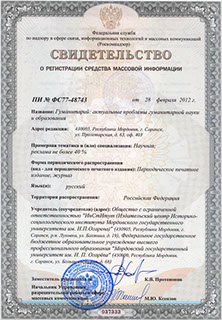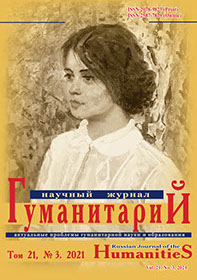ГуманитариЙ актуальные проблемы гуманитарной науки и образования
Russian Journal of the Humanities
ISSN 2078-9823 (Print)
ISSN 2587-7879 (Online)
Navigation
ISSN 2078-9823 (Print), ISSN 2587-7879 (Online)
DOI: 10.15507/2078-9823.055.021.202103.312-322
Vladimir P. Andronov
National Research Ogarev Mordovia State University (Saransk, Russia),
e-mail: andronovvp@rambler.ru
Psychological Features of Creative Thinking of Younger and Older Adolescents
Introduction. The relevance of the problem is due to the theoretical and practical significance of the study of the specifics of creative thinking in adolescence. Objective. To identify the psychological characteristics of creative thinking in younger and older adolescents. Materials and Methods. Theoretical and empirical methods were used in the research. As a diagnostic tool, a modified version of the Gilford technique and a shortened version of the Torrence creativity test are used. Results. Four levels of creative thinking development were identified and described: average, below average, above average, high. The characteristic feature of the development of creative thinking of older adolescents is the uneven development of its main indicators. When comparing the data obtained in younger and older adolescents, there is some lag in the first indicators such as fluency and flexibility of thinking. Nonverbal creative thinking is better developed in the group of older teenagers due to better detailing of answers and ideas. In General, the indicators of flexibility of thinking are lower than the indicators of fluency in both samples. The study determined the nature of the relationship between creativity and the level of intelligence of the subjects. For this purpose, the coefficient of rank correlation rs Spearman was used. Discussion and Conclusions. Adolescence is a special period in the development of thinking in ontogenesis, since it is in the middle classes that children first begin trading to study systematic courses in a number of disciplines where, unlike primary school, truly scientific concepts are presented. Based on these concepts, students develop ways of their actions to solve the relevant problems. This circumstance radically changes their thinking. The results can be used in the process of organizing the educational process with students in the study of disciplines of the psychological cycle, in the activities of the psychological service of universities, as well as school psychologists.
Keywords: creative thinking, adolescence, creativity, intelligence.
For citation: Andronov V. P. Psychological Features of Creative Thinking of Younger and Older Adolescents. Gumanitarian : aktual’nye problemy gumanitarnoi nauki i obrazovaniia = Russian Journal of the Humanities. 2021; 21(3): 312–322 (In Russ.). DOI: 10.15507/2078-9823.055.021.202103.312-322.

© Ogarev Mordovia State University. History and Sociology Institute, 2017
68, Of. 411, Bolshevistskaya St., 430005, The editorial office of the scholarly journal «Russian Journal of the Humanities»
Tel.: (8342) 24-25-90; 27-07-11, Fax: (8342) 24-25-90, E-mail: jurnal-econom-hist@isi.mrsu.ru
Designed by A. Napalkov, Email: napalkov@isi.mrsu.ru

